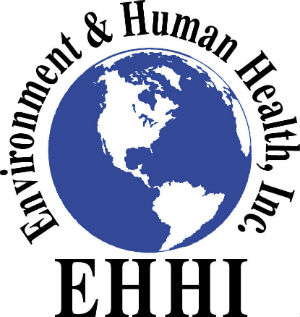Obesity: Press Release
Prompted by rising rates of childhood obesity, Environment and Human Health, Inc. has just completed a yearlong, comprehensive research study that looks at the state of nutrition and physical activity in schools. Environment and Human Health, Inc. (EHHI) is a nine-member, non-profit organization composed of doctors, public health professionals and policy experts. This groundbreaking study includes information from on-site visits to
62 schools, where the researcher interviewed principals, food service
directors, cafeteria staff, physical education and nutrition teachers
and students. The schools that were visited represent a cross-section
of public schools. Every county in Connecticut is represented, as well
as every level of school, including grammar, middle, and high school.
Schools were also included from every Economic Reference Group (ERG),
which is a classification used by the Board of Education to group together
schools with similar socioeconomic status. The study's findings are so extensive that the report is divided into
six chapters, which represent every facet of the school environment having
to do with food and physical activity. Every chapter has its own summary
of findings and its own set of recommendations that pertain to that chapter's
subject matter. The six chapters of the report cover: 2. The National School Lunch Program. This is the largest child nutrition
program in the country and ninety-five percent of the schools in this
study participated in this program; 3. Foods sold by school cafeterias in competition with the National
School Lunch Program. These foods are often high in fat, high in added
sugar and high in calories; 6. Physical education and physical activities in schools. Sadly, both
opportunities for physical activity and physical education are decreasing
despite the fact that physical activity is critical to reducing obesity
and overweight prevalence among our school children. Articles in the The American Journal of Public Health and The Journal
of the American Medical Association point to school environments as having
powerful influences on children’s eating behaviors. In addition,
the Surgeon General has identified schools as being “key” settings
for preventing and/or decreasing obesity and overweight prevalence among
school children. Research has also found that the influence of the school
environment on eating behaviors extends beyond the school day and that
the foods to which students are exposed in school shape their eating
habits outside of school as well. Eighty percent of the schools in this study offered opportunities for
students to eat and drink outside the lunchtime cafeteria. Eighty-one
percent of the high schools in this study had school-operated vending
machines and one high school had as many as 15 school-run vending machines. “The
State should impose nutritional requirements on all food and beverage
items sold in school,” says Susan Addiss, past commissioner of
the Connecticut Department of Public Health and current director of health
education at Environment and Human Health, Inc. “Sales of ‘extra
foods’ such as soda and candy should not be permitted at any time
during the school day, at any school level.” EHHI’s research found that food items come into schools from many
different sources. Cupcakes and sweets come in for birthday parties,
school fundraisers sell candy items and cookies, while cakes and sweet
breads arrive at bake sales. There are also classroom parties, school-operated
vending machines, and food-based rewards given for either academic achievement
or good behavior. Chocolate candy and lollipops are often sold as fund
raisers and were available on a relatively regular basis. The study found
that these candy items were often consumed by students while they were
in school. “Childhood obesity creates a variety of negative health effects
both acute and long-term,” says D. Barry Boyd, M.D., an oncologist
at Greenwich Hospital, an affiliate member of Yale’s Cancer Center
and a board member of Environment and Human Health, Inc. “Obese
and overweight children and adolescents have an increased risk of developing
diabetes 2, which one study found to have increased 10-fold from 1982
to 1994. Eighty-five percent of children with Type 2 diabetes are either
overweight or obese at diagnosis.” The study found that physical exercise and physical education were woefully
lacking in schools. Elementary and middle school students receive, on
average, less than half the time for physical education per week than
is nationally recommended. High school students, on average, receive
less than one-third the time that is nationally recommended. “Physical
education is part of the solution to having healthy children,” says
Robert La Camera, M.D., clinical professor of pediatrics at Yale University,
and a board member of Environment and Human health, Inc. “Schools
should schedule physical education classes at regular intervals throughout
the year and these classes should be long enough and structured such
that students engage in at least 20 minutes of aerobic activity in every
class. Elementary school students should have a daily recess and that
students should be encouraged to be active during that time.” “Marginalizing physical education in schools is sending the wrong
message to students about the importance of exercise and its contribution
to good health,” explains Cynthia Curl Henderson, the study’s
primary researcher. “For more than one-third of the high schools
in this study to require just two semesters of physical education over
the entire four years of their high school education is simply not adequate.
The state presently has absolutely no requirements as to the amount of
physical education that must be offered in schools nor how often or consistently
it should be scheduled.” Kelly Brownell, Ph.D., professor and chair of the Department of Psychology
at Yale University and author of Food Fight (the newly published book
from McGraw-Hill), adds, “The health and well-being of America's
children are in peril, due in part to declining physical activity and
a disastrous food environment. Schools offer an excellent place to think
creativity about how this situation might be reversed.” “This is exactly what this report aims to do,” says EHHI’s
Nancy Alderman. 
1. How much time children have to eat their lunch. The amount of time
varies from school to school and student to student. In some schools
the last student in line can have as few as seven minutes;
4. All the other foods available in schools. These include foods sold
in bake sales, foods sold for fundraisers, at student-run stores, in
school-operated vending machines, and food brought in for birthday parties
and other celebrations;
5. Nutrition education in schools. This study found that even the schools
with the greatest amount of time devoted to nutrition education were
still far below national recommendations;
“ This comprehensive report lays out not only what is
actually going on in our schools with respect to nutrition and physical activity,
but also gives schools, school districts and legislators a roadmap of constructive
ways to fix many of the problems found by this original research,” says
Nancy Alderman, president of Environment and Human Health, Inc.
